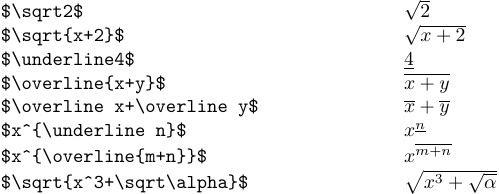3. Comandos de LaTeX
Outra maneira de construir fórmulas complexas a partir de simples é usar os comandos \sqrt, \sublline ou \overline. Eles também se aplicam ao personagem ou subformula que os segue:

Você também pode obter raízes de cubo e coisas semelhantes:

These three commands place lines above and below subformulas of any size and shape; the bar lines change their size and position, so that they are long enough to cover the subformula, and high enough or low enough not to overlap with it. In particular, square root signs appear in a variety of positions depending on the height and depth of what’s being \sqrt‘ed:
 In such a case, you may want to typeset all square roots uniformly, like this:
In such a case, you may want to typeset all square roots uniformly, like this:
 The easy way to do this is to use the command
The easy way to do this is to use the command \mathstrut:
1$\sqrt{\mathstrut a} + \sqrt{\mathstrut d} + \sqrt{\mathstrut y}$.A \mathStrut é uma caixa invisível de largura zero. Sua altura e profundidade são a altura e a profundidade de um parêntese ‘(’. Segue -se que as subformulas que contêm \mathstrut sempre terão a mesma altura e profundidade, a menos que envolvam construções mais complicadas, como subscritos e superestritos.